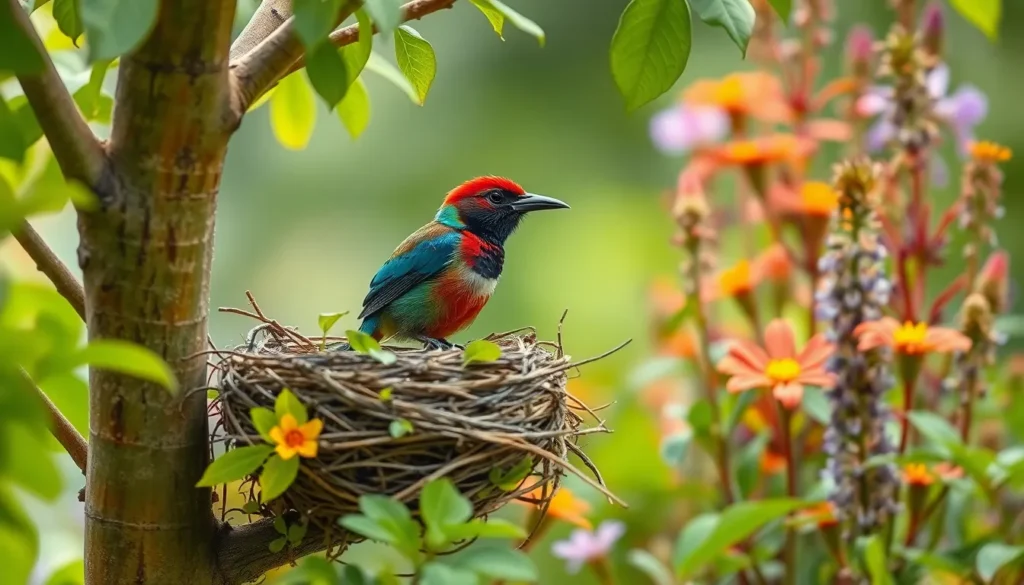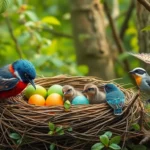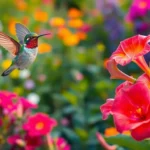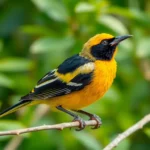We’ve all witnessed the remarkable sight of birds carefully weaving twigs and gathering materials to create their homes. Bird nest building represents one of nature’s most fascinating architectural feats, showcasing incredible instinct and engineering prowess that puts human construction to shame.
From the intricate cup-shaped nests of robins to the massive communal structures of social weaver birds, each species has developed unique building techniques passed down through generations. These feathered architects don’t need blueprints or tools – they rely on evolutionary wisdom and environmental awareness to create safe havens for their young.
Understanding how birds build nests opens our eyes to the complexity of avian behavior and the delicate balance of ecosystems around us. We’ll explore the materials they choose, the construction methods they employ, and the incredible variety of nest designs that make each species’ approach truly extraordinary.
Understanding the Science Behind Bird Building Nest Behavior
Behind every nest construction project lies complex biological programming that drives birds to create these remarkable structures. We’re diving into the fascinating science that explains how and why birds build their intricate homes.
Instinctual vs. Learned Behaviors
Instinctual programming forms the foundation of nest building behavior across bird species. Birds inherit genetic blueprints that guide their construction techniques without any prior teaching or experience. Young robins automatically know to collect mud and twigs for their cup-shaped nests while orioles instinctively weave hanging pouches from plant fibers.
Learned behaviors enhance and refine these inherited patterns through experience. Juvenile birds observe their parents and neighboring species to improve their construction skills over successive breeding seasons. Research shows that experienced birds create stronger nests with better materials compared to first-time builders who rely solely on genetic programming.
Environmental adaptation combines both instinct and learning to optimize nest success. Birds modify their inherited patterns based on local conditions like available materials and predator threats. Crows in urban environments have learned to incorporate wire and plastic into their traditional stick nests while maintaining their species-exact architectural style.
Hormonal Triggers and Seasonal Timing
Rising testosterone levels in males initiate the nest building sequence during breeding season. These hormonal surges occur 4-6 weeks before mating season peaks causing male birds to begin territory establishment and preliminary construction activities. Scientists have documented testosterone increases of 200-400% in breeding males compared to non-breeding periods.
Estrogen and prolactin levels in females synchronize with nest completion and egg laying phases. Female birds experience hormonal changes that trigger material gathering behaviors approximately 10-14 days before ovulation begins. This precise timing ensures nest readiness coincides with reproductive needs.
Photoperiod changes signal seasonal breeding cycles that control nest building timing. Increasing daylight hours trigger hormonal cascades in birds’ hypothalamus regions starting their annual reproductive sequences. Most temperate species begin construction when daylight reaches 12-14 hours daily correlating with spring conditions optimal for raising young.
Species-Exact Nest Building Patterns
Genetic programming determines unique construction methods that identify each species’ architectural style. Weaverbirds create intricate hanging baskets using exact knot-tying techniques while hummingbirds build tiny cups decorated with lichen camouflage. These patterns remain consistent across geographic populations proving their genetic basis.
Material preferences reflect evolutionary adaptations to exact ecological niches and habitat requirements. Arctic terns line their ground nests with soft feathers and moss for insulation while desert species like cactus wrens use thorny materials for predator protection. Each species’ material choices optimize nest success in their particular environment.
Construction sequences follow predictable stages that maximize structural integrity and energy efficiency. Most cup-nesting birds start with a foundation platform then build upward walls before adding soft lining materials. This standardized approach appears across diverse species suggesting common evolutionary origins for nest building behaviors.
Selecting the Perfect Location for Bird Building Nest Sites
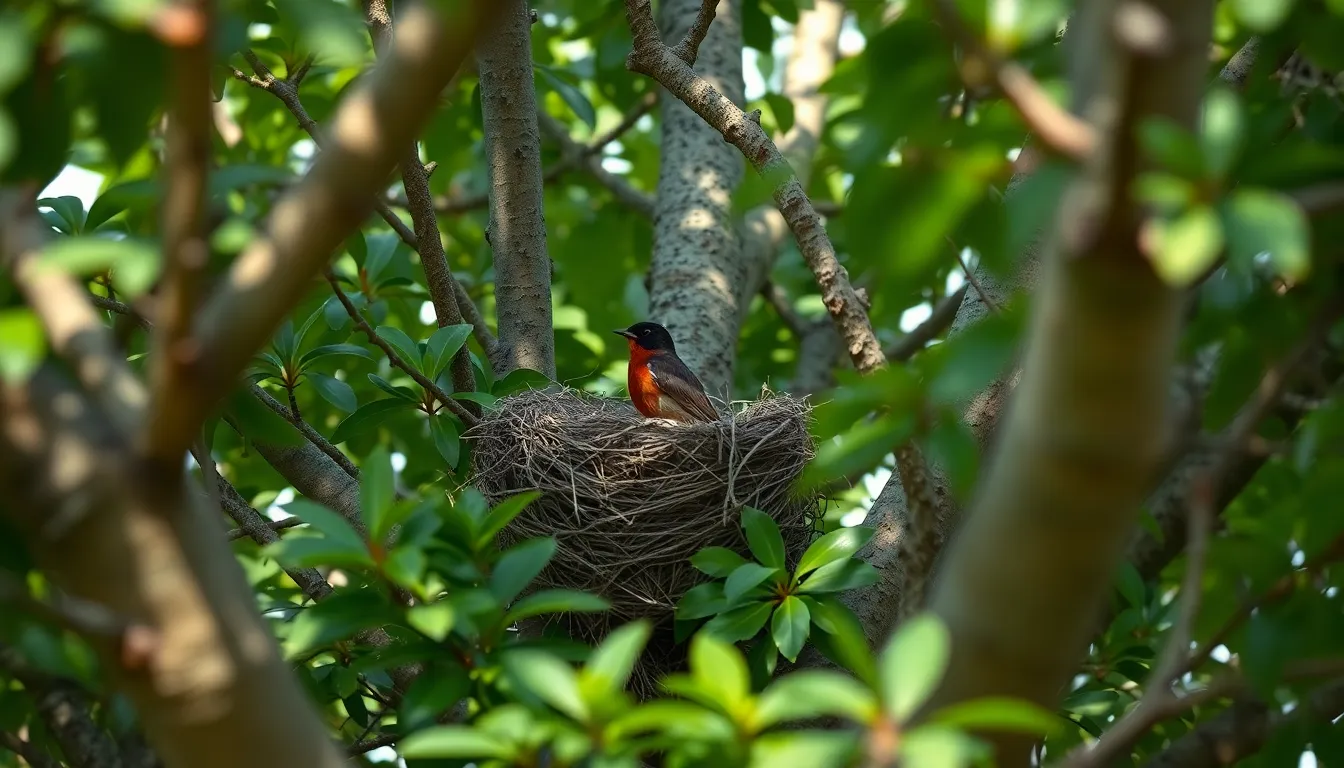
Once birds understand the construction science behind their architectural endeavors, they face the critical decision of where to build. Strategic location selection determines whether their offspring survive or become vulnerable to countless threats.
Safety Considerations and Predator Avoidance
Height becomes the primary defense mechanism for most bird species when selecting nest sites. We observe robins positioning their nests 5 to 15 feet above ground in tree forks, while house finches prefer 6 to 12 feet on building ledges or dense shrubs. These elevated positions create natural barriers against ground predators like cats, raccoons, and snakes.
Dense vegetation offers crucial concealment from aerial predators such as hawks and owls. Cardinals typically choose thorny bushes or thick evergreen branches that obscure their nests from above. The tangled branches create multiple escape routes while deterring larger predators from approaching.
Strategic positioning near human activity provides unexpected protection for many urban bird species. House sparrows frequently build under eaves or in wall cavities near busy areas where human presence keeps most predators at bay. This adaptation demonstrates how birds leverage our activities for their survival advantage.
Multiple exit pathways ensure quick escapes when danger approaches. Wrens select nest boxes or cavities with clear flight paths in several directions, allowing rapid departure without obstacles. They avoid locations surrounded by thick branches that could trap them during emergency situations.
Weather Protection and Microclimate Factors
Shelter from prevailing winds influences nest placement in every habitat we study. Woodpeckers excavate their cavities on the leeward side of trees, typically facing southeast to avoid harsh northern winds. This positioning reduces heat loss during cold nights while preventing rain from entering the nest opening.
Optimal sun exposure regulates internal nest temperatures throughout the day. Eastern bluebirds choose nest boxes facing east or southeast to capture morning warmth without experiencing excessive afternoon heat. The positioning helps maintain consistent temperatures for proper egg incubation and chick development.
Natural rain protection determines survival rates during storm seasons. Mourning doves build their flimsy platform nests under protective overhangs created by larger branches or leaves. These natural umbrellas prevent eggs and nestlings from getting soaked during heavy rainfall.
Microclimate stability affects long term nesting success more than we initially realized. Tree cavities maintain more consistent temperatures than exposed nests, which explains why cavity nesting species like chickadees show higher survival rates. The surrounding wood acts as insulation against temperature fluctuations.
Resource Availability and Territory Claims
Proximity to food sources drives territory selection for most breeding birds. Swallows establish nests within 100 yards of water bodies where insects congregate, ensuring abundant prey for growing chicks. They won’t waste energy flying long distances when feeding demands peak during breeding season.
Water access becomes non negotiable for species raising multiple broods annually. Song sparrows territory boundaries always include reliable water sources within 50 yards of their nest sites. Clean water supports both adult hydration and the production of nutritious crop milk for offspring.
Material gathering efficiency shapes the final nest location decision. Baltimore orioles suspend their hanging nests near meadow edges where grasses and plant fibers grow abundantly. This strategic placement reduces construction time and energy expenditure during the critical building phase.
Territorial boundaries establish exclusive resources for successful reproduction. Red winged blackbirds defend marshland territories averaging 0.25 acres, providing sufficient cattail stems for nest construction plus adequate foraging areas. Males aggressively patrol these boundaries to prevent resource competition from neighboring pairs.
Gathering Essential Materials for Bird Building Nest Construction
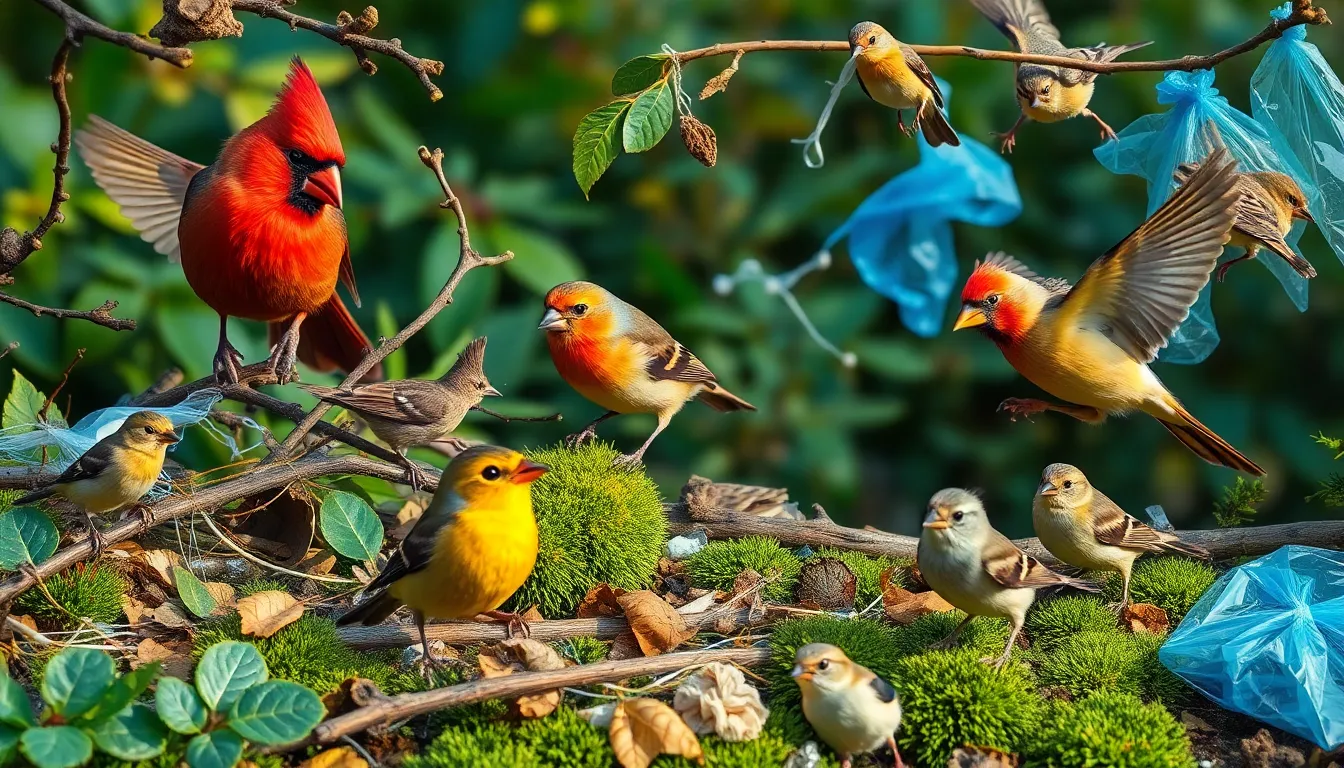
After selecting the perfect location, birds embark on the crucial task of material collection. We observe this methodical process across countless species as they demonstrate remarkable resourcefulness in gathering construction supplies.
Natural Materials: Twigs, Leaves, and Moss
Twigs serve as the primary structural foundation for most bird nests. Cardinals and mockingbirds carefully select flexible branches ranging from 2 to 6 inches in length, ensuring they bend without breaking during construction. We find these birds test twig strength by applying pressure before incorporating them into their framework.
Leaves provide essential insulation and camouflage properties. Robins and thrushes prefer fresh green foliage that maintains moisture and flexibility, while finches often collect dried leaves that offer superior wind resistance. These materials create natural temperature regulation within the nest cavity.
Moss acts as nature’s perfect cushioning and weatherproofing material. Chickadees and nuthatches gather soft moss varieties like cushion moss and sheet moss, which retain moisture during dry periods and provide antimicrobial properties. We notice these birds often collect moss from north facing surfaces where it remains consistently damp.
Bark strips offer waterproof exterior protection. Woodpeckers and flickers specifically target birch and cedar bark, which naturally repels water and provides flexible binding material. These strips interweave with other materials to create weatherproof outer shells.
Grass and plant fibers form the nest’s binding system. Sparrows and warblers collect long grass stems and plant fibers that act like natural rope, securing structural elements together. We observe they prefer materials with natural tensile strength that won’t deteriorate quickly.
Human Made Materials Birds Adapt for Nesting
Plastic bags and packaging materials provide waterproof nest linings. House finches and house sparrows incorporate thin plastic strips into their constructions, creating moisture barriers that protect eggs and chicks. We document these birds carefully selecting colorless materials that won’t attract predators.
String and yarn offer superior binding capabilities. Robins and blue jays frequently collect discarded string, fishing line, and yarn scraps that provide stronger connections than natural plant fibers. These materials allow birds to secure nests to challenging attachment points like metal structures.
Cotton and fabric scraps create soft nest interiors. Goldfinches and wrens gather cotton batting, cloth pieces, and dryer lint to line their nests with comfortable padding. We find these materials particularly common in urban bird populations with access to human textile waste.
Wire and metal fragments serve as structural reinforcement. Crows and magpies incorporate thin wire pieces and small metal objects to strengthen nest frameworks, particularly in windy environments. These intelligent birds recognize the superior durability of manufactured materials.
Paper products add insulation and padding layers. Many songbirds collect tissue paper, newspaper scraps, and cardboard fragments that provide excellent insulation properties. We observe birds shredding these materials into optimal sizes for their exact construction needs.
Species Exact Material Preferences
Hummingbirds prioritize spider silk and plant down for elasticity. These tiny architects collect spider webs and dandelion seeds to create nests that expand as chicks grow. We measure hummingbird nests that stretch from 2 inches to 4 inches in diameter during the fledgling period.
Orioles specialize in fiber weaving techniques. Baltimore orioles and Bullock’s orioles gather long grass fibers, animal hair, and string to create hanging basket nests. These birds demonstrate advanced weaving skills, creating structures that support up to 3 times their body weight.
Swallows prefer mud and saliva combinations. Barn swallows and cliff swallows collect mud pellets mixed with their saliva to construct cup shaped adobe structures. We document these birds making up to 1,000 individual trips to gather sufficient building material.
Woodpeckers excavate rather than collect materials. Pileated woodpeckers and red headed woodpeckers create cavity nests by removing wood chips rather than gathering external materials. These birds can excavate chambers 8 to 20 inches deep in dead or dying trees.
Social weavers create communal material stockpiles. These African birds collectively gather thousands of grass stems and twigs to build apartment style structures housing up to 400 breeding pairs. We observe these communities maintaining shared material caches throughout the breeding season.
Mastering the Architecture of Bird Building Nest Techniques
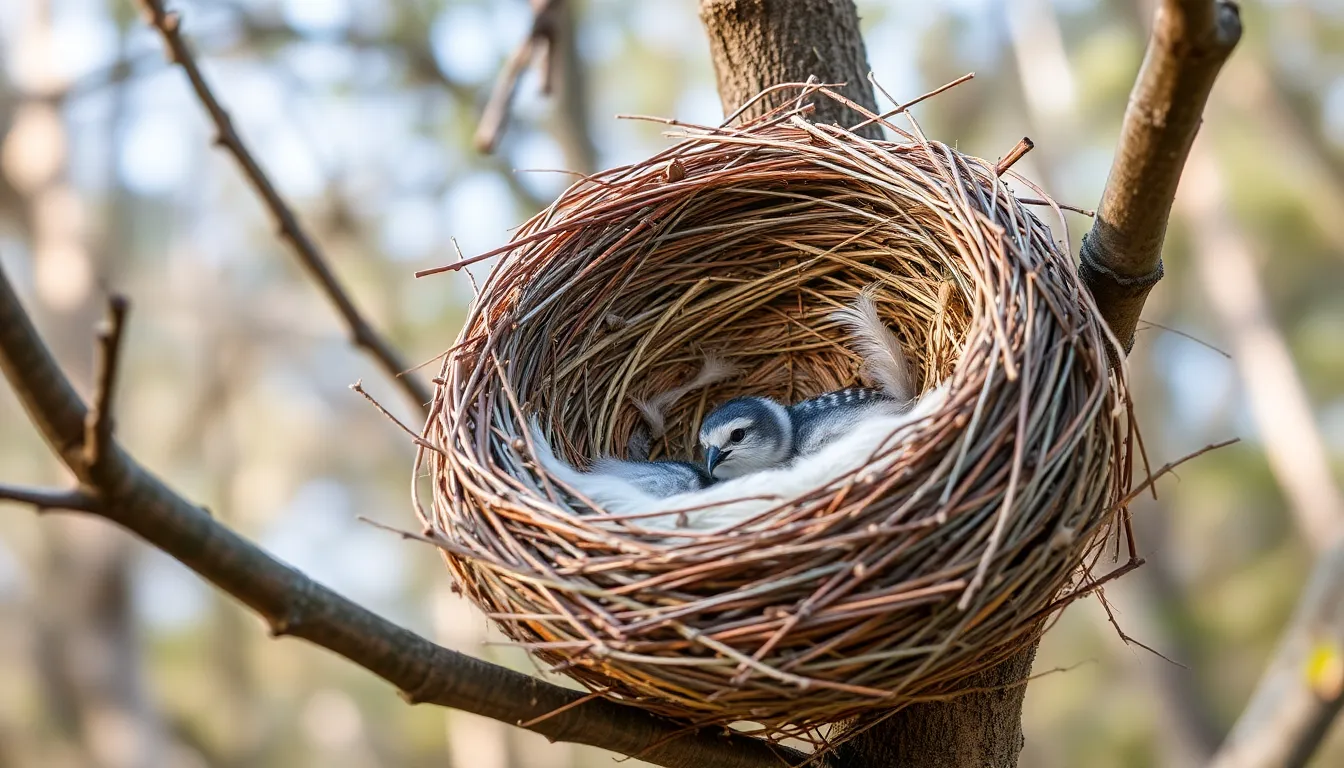
Birds employ sophisticated construction methods that rival human engineering principles. We’ll explore the precise techniques that make avian architecture so remarkably effective.
Foundation Building and Structural Support
Foundation construction begins with strategic placement of primary support materials. Cardinals typically anchor their nests using sturdy twigs arranged in triangular patterns that distribute weight evenly across supporting branches. We observe that robins create bowl-shaped foundations by weaving together coarse materials like grass stems and small branches to establish the basic nest framework.
Load-bearing elements receive careful positioning during the early construction phases. Mourning doves arrange platform foundations using flat materials that span multiple branch intersections for maximum stability. Structural reinforcement occurs when birds like blue jays interlace heavier materials with flexible plant fibers to create shock-absorbing foundations that withstand wind stress.
Weight distribution strategies vary significantly among different bird families. Crow families build substantial platforms capable of supporting multiple occupants by layering thick branches in crisscross patterns. Support beams get strategically positioned by woodpeckers who excavate circular chambers with reinforced entrance holes that prevent structural collapse.
Weaving and Interlocking Methods
Weaving techniques demonstrate remarkable precision in material manipulation and pattern creation. Baltimore orioles showcase master-level basket weaving by creating pendulous nests with intricate fiber interlacement patterns that provide both flexibility and strength. We find that these birds use over-under weaving motions similar to human textile production methods.
Interlocking systems create seamless connections between individual nest components. House finches employ spiral wrapping techniques where they wind long grasses around branch intersections to secure the nest structure. Binding methods include twisted fiber connections that tighten naturally as materials dry and contract.
Advanced construction methods involve multi-layered architectural approaches. Red-winged blackbirds weave outer shells using coarse marsh grasses while simultaneously creating inner frameworks with finer plant materials. Tension control becomes critical as birds adjust material tightness to accommodate thermal expansion and seasonal weather changes.
Pattern recognition guides systematic material placement throughout the construction process. Goldfinches create uniform cup shapes by following consistent circular weaving patterns that maintain structural symmetry. We observe that experienced builders complete complex weaving sequences faster than younger birds still developing their technique mastery.
Interior Lining and Comfort Features
Interior finishing involves specialized materials that enhance temperature regulation and chick comfort. House wrens line their cavity nests with soft feathers, animal fur, and cotton-like plant fibers that create insulating layers for developing eggs and nestlings. We notice that these lining materials often possess antimicrobial properties that reduce disease transmission risks.
Comfort optimization includes strategic placement of cushioning materials in high-traffic areas. Eastern bluebirds concentrate soft grasses and feathers in the nest bottom where eggs rest while using coarser materials along the walls for structural support. Padding thickness varies according to clutch size expectations and local temperature conditions.
Temperature control features incorporate materials with exact thermal properties. Chickadees select moss and lichen pieces that retain heat during cold nights while providing cooling effects during warm days. We find that cavity-nesting species often create multiple comfort zones within single nests to accommodate different developmental stages.
Drainage systems prevent moisture accumulation through careful material selection and placement. Tree swallows incorporate materials that wick moisture away from eggs while allowing air circulation through the nest structure. Water management becomes essential for preventing fungal growth and maintaining healthy nesting environments for successful reproduction.
Exploring Different Types of Bird Building Nest Styles
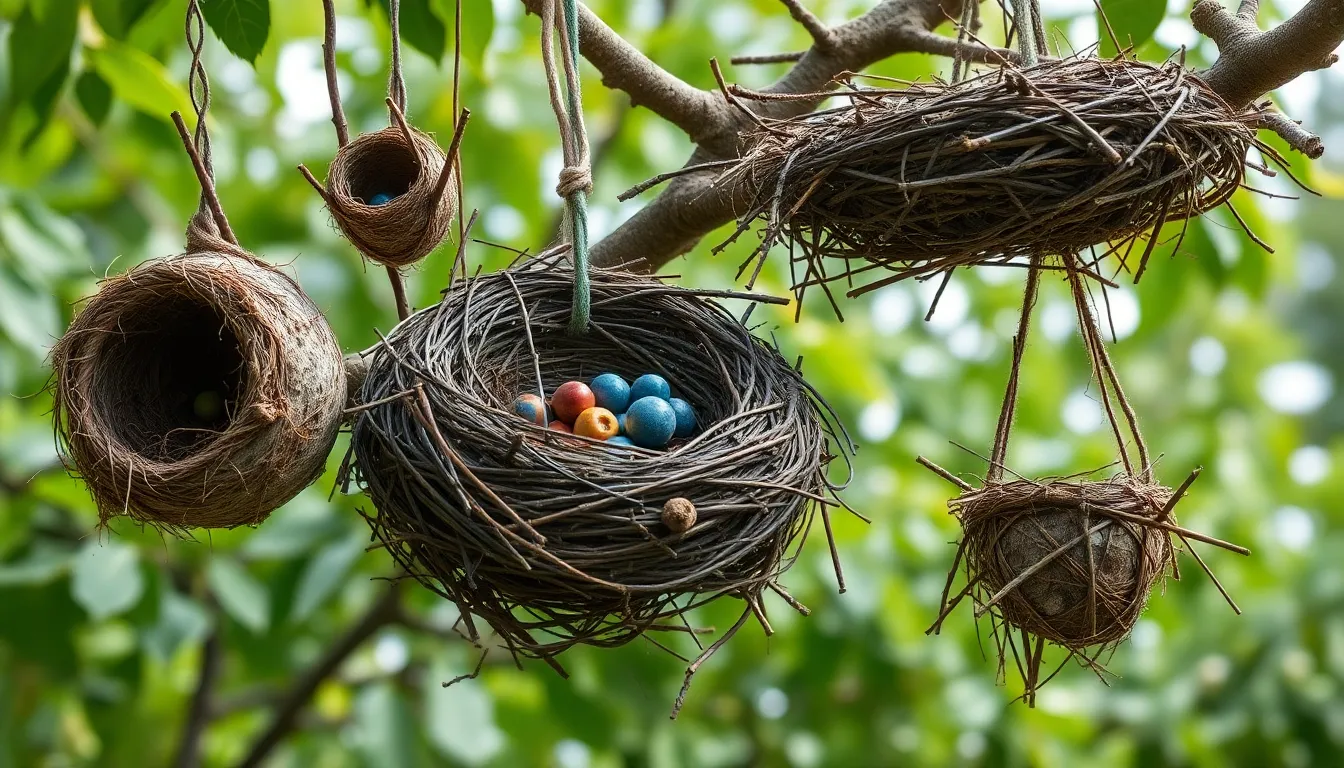
Different bird species have evolved distinct architectural approaches to create their homes. We’ll examine the three primary nest construction styles that showcase remarkable engineering diversity.
Cup Nests and Platform Nests
Cup nests represent the most common design pattern among songbirds like robins, cardinals, and sparrows. These bowl-shaped structures feature curved walls that cradle eggs and provide wind protection while maintaining optimal heat distribution for incubation.
Platform nests take a minimalist approach with flat construction styles used by mourning doves, hawks, and eagles. Birds create these structures using loosely arranged twigs and branches without deep bowl formations. Large raptors like bald eagles construct massive platform nests that can weigh over 2,000 pounds and measure 8 feet across.
Structural differences between these designs reflect exact evolutionary needs and habitat requirements. Cup nest builders focus on creating secure enclosures for smaller eggs and chicks. Platform nest species typically produce larger offspring that require more surface area for movement and growth.
Materials selection varies significantly between these two styles. Cup nest architects like American robins use mud as mortar to bind twigs together before adding soft interior linings. Platform builders rely primarily on interlocking branch arrangements without adhesive materials.
Cavity Nests and Burrow Construction
Cavity nests offer maximum protection from predators and weather through enclosed spaces within trees, rocks, or artificial structures. Primary excavators like woodpeckers create these hollows using specialized bills and reinforced skull structures that absorb impact forces.
Secondary cavity nesters including bluebirds, chickadees, and house wrens occupy pre-existing holes without excavation abilities. These species often compete intensely for suitable cavities during breeding season.
Burrow construction requires different skill sets as birds like kingfishers, bank swallows, and puffins excavate tunnels in soil or sand banks. These underground architects can create passages extending 3 to 4 feet deep with enlarged nesting chambers at the end.
Excavation techniques vary among species based on bill strength and foot structure. Belted kingfishers use their bills like pickaxes while scratching backward with their feet to remove loose material. Bank swallows work in colonies to create honeycomb patterns of tunnel entrances in suitable cliff faces.
Hanging Nests and Elaborate Structures
Hanging nests demonstrate advanced weaving skills as birds like Baltimore orioles and pendulum tits create suspended pouches from tree branches. These gravity-defying structures sway with wind currents while protecting contents from climbing predators.
Elaborate architectural designs reach their peak with social weavers in Africa who construct apartment-style communal nests housing hundreds of breeding pairs. These massive structures can span 20 feet wide and contain over 100 individual chambers with shared maintenance responsibilities.
Engineering complexity increases with species like baya weavers who create entrance tunnels at the bottom of hanging nests to prevent egg spillage during storms. Males often build multiple test nests to attract females who inspect construction quality before selecting mates.
Construction time varies dramatically among elaborate builders. Simple hanging nests require 5 to 10 days of intensive weaving work. Communal structures like those built by social weavers represent multi-generational projects that expand continuously over decades.
Timing Considerations for Bird Building Nest Seasons
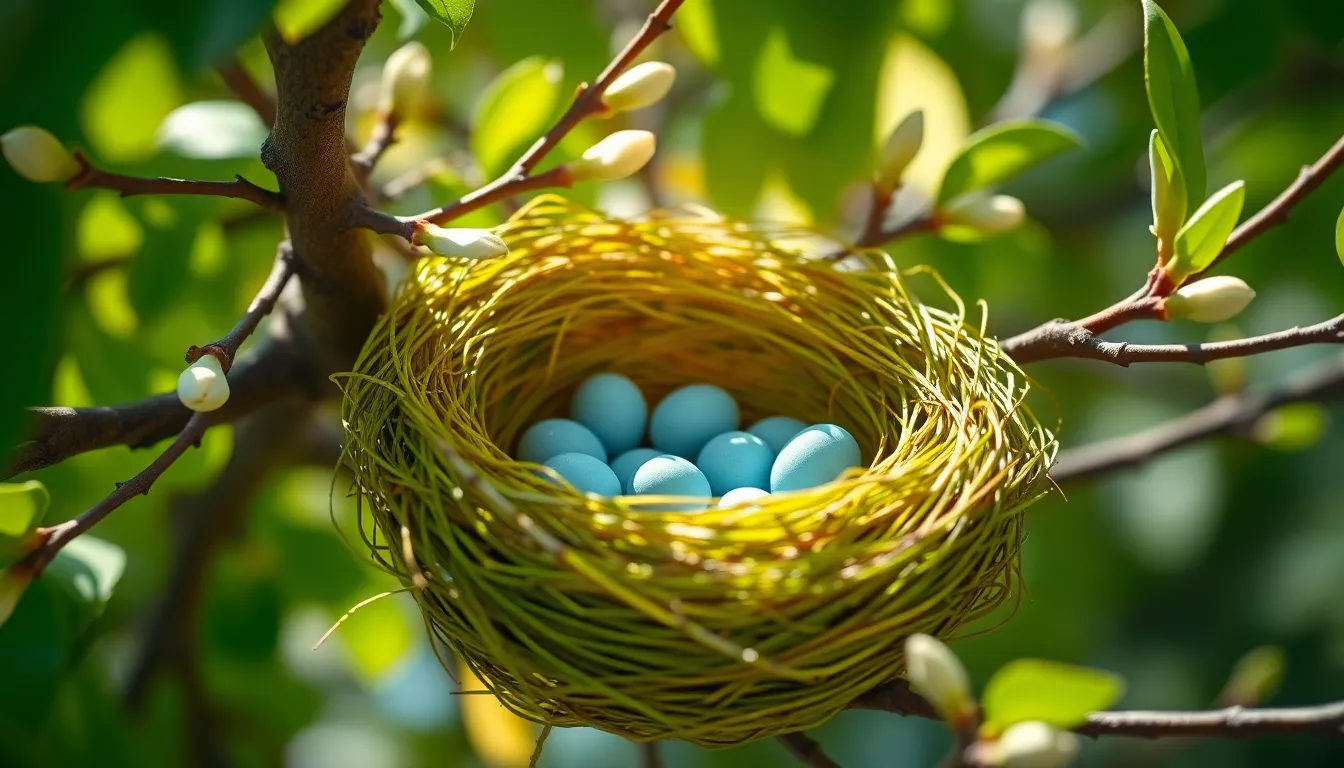
Understanding when birds build their nests is crucial for observing their fascinating construction behaviors. Seasonal timing directly impacts nest success rates and offspring survival throughout different bird species.
Spring Migration and Breeding Cycles
Spring migration triggers the most intensive nest building period across North America, typically beginning in March and extending through June. Migratory species like American robins arrive when daylight hours reach exact thresholds, usually around 12 hours of sunlight daily. Temperature consistency plays a crucial role, with most songbirds initiating construction when average daily temperatures stabilize above 45°F for seven consecutive days.
Early arrivals gain important territorial advantages during prime nesting season. House wrens return to breeding grounds 2-3 weeks before peak construction begins, allowing them to scout optimal locations. Cardinals and blue jays start gathering materials in late February across southern regions, while their northern counterparts delay until April. Hormonal changes triggered by increasing daylight activate breeding behaviors, with testosterone levels rising 300-400% in male birds during this critical period.
Migration timing varies dramatically between species based on their food requirements and breeding strategies. Insect eating birds like flycatchers arrive later in spring when bug populations peak, typically May through early June. Seed eating finches begin earlier since plant materials remain available throughout winter months. Weather patterns influence arrival dates by up to three weeks, with mild winters advancing schedules and harsh springs creating delays.
Multiple Broods and Nest Reuse
Many bird species attempt multiple broods during a single breeding season, requiring strategic timing between construction cycles. American robins commonly raise 2-3 broods annually, with subsequent nests built within 100-200 yards of previous sites. House finches demonstrate remarkable productivity, potentially completing up to 6 broods in favorable conditions. Each breeding cycle requires 4-6 weeks from construction to fledgling independence.
Nest reuse strategies differ significantly among various bird families and construction styles. Platform builders like mourning doves frequently renovate existing structures, adding fresh materials to previous year foundations. Cup nest architects typically construct new homes for each brood, though they’ll gather materials from abandoned nests nearby. Cavity nesters show the highest reuse rates, with woodpecker holes serving multiple generations across several years.
Timing between broods affects construction methods and material selection throughout the breeding season. Second broods often feature simpler designs requiring 2-3 fewer construction days compared to initial nests. Parent birds prioritize speed over elaborate features during later attempts, focusing on essential structural elements. Late season nests typically use more readily available materials like dried grasses instead of premium options like moss or animal hair.
Climate Change Effects on Nesting Timing
Rising temperatures are advancing nest building schedules by an average of 6-14 days across temperate regions over the past three decades. Earlier spring warmth triggers hormonal responses sooner, causing birds to begin construction before optimal food sources become available. This mismatch creates challenges for species that time breeding cycles with insect emergence patterns. Temperature records show average spring temperatures have increased 2.5°F since 1990 in northern breeding areas.
Extreme weather events disrupt traditional nesting patterns through unpredictable timing and intensity changes. Late season freezes destroy partially built nests, forcing birds to restart construction during suboptimal periods. Heavy rainfall during peak building season reduces material availability and increases construction time by 40-60%. Drought conditions limit mud availability for species like barn swallows and limit nesting success rates.
Range shifts are altering regional nesting schedules as bird populations track suitable climate conditions northward. Species like house finches now breed 100-200 miles further north compared to historical ranges. Northern populations experience compressed breeding seasons, attempting the same number of broods in shorter timeframes. Southern populations extend breeding periods but face increased heat stress during summer months, affecting nest success rates and chick survival.
Common Challenges Birds Face During Bird Building Nest Process
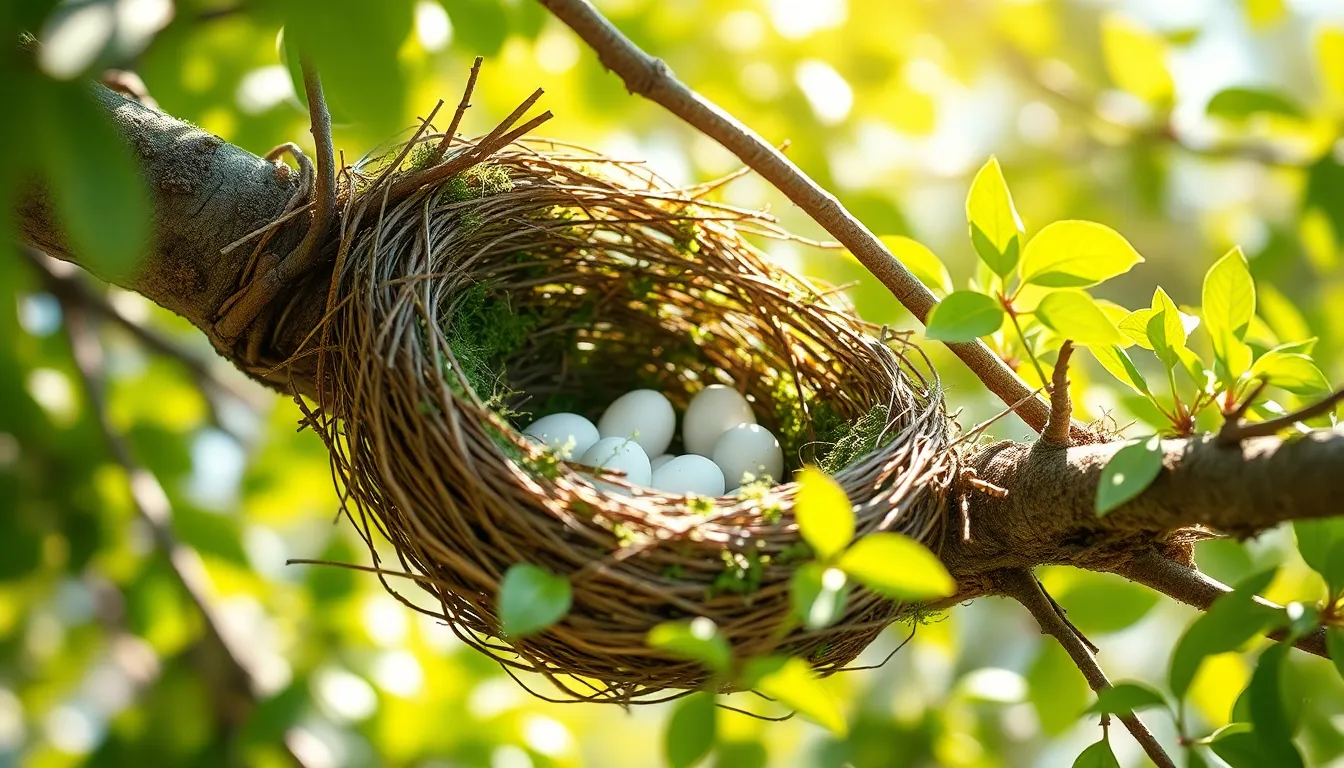
Even though their remarkable instincts and engineering skills, birds encounter many obstacles that can derail their construction efforts. These challenges threaten nest success rates and require birds to adapt their building strategies throughout the breeding season.
Weather Disruptions and Material Shortages
Sudden storms destroy partially constructed nests, forcing birds to restart their building process from scratch. Rain saturates natural materials like moss and leaves, making them too heavy for delicate structures and causing nest foundations to collapse under the additional weight.
Extended drought periods create severe material shortages that limit construction options for nest building birds. Dry conditions make finding suitable mud impossible for swallows and other species that rely on wet clay for their architectural designs. Trees produce fewer flexible twigs during drought years, while grass becomes brittle and unusable for weaving species like orioles.
Temperature fluctuations affect material availability throughout the nesting season. Late frost kills emerging buds that birds typically gather for soft interior lining, while unseasonably warm weather causes spider silk to become sticky and difficult to manipulate. Wind storms scatter collected materials across territories, requiring birds to expend additional energy gathering replacement resources.
Material quality decreases when weather patterns disrupt natural cycles that birds depend on for construction supplies. Fungal growth on bark strips during wet seasons makes them unsuitable for nest building, while excessive heat dries out flexible materials before birds can properly weave them into their structures.
Human Interference and Habitat Loss
Construction activities destroy established territories where birds have already invested time scouting optimal nest locations. Heavy machinery removes mature trees that provide essential nesting sites for cavity dwelling species, while demolition creates noise pollution that disrupts normal building behaviors.
Urban development fragments natural habitats, forcing birds to build nests in suboptimal locations with higher predation risks. Parking lots and buildings replace native vegetation that birds rely on for both nesting materials and camouflage protection. Light pollution from streetlights and buildings confuses nocturnal nest building activities and alters hormone cycles that trigger construction behaviors.
Chemical treatments on lawns and gardens contaminate natural materials that birds collect for nest construction. Pesticides weaken the structural integrity of plant fibers, while fertilizers alter the pH levels in mud and clay used by species like barn swallows. Road salt residue on winter materials persists into spring, creating toxic nest environments that harm developing chicks.
Human activity near nest sites causes birds to abandon construction projects midway through completion. Dog walking, landscaping, and outdoor recreation in nesting areas create constant disturbances that prevent birds from maintaining their building schedules. Window strikes during material gathering flights reduce adult bird populations and disrupt established breeding pairs.
Competition from Other Birds
Territory disputes force birds to relocate and rebuild nests multiple times during a single breeding season. Aggressive species like house sparrows evict smaller birds from prime nesting locations, stealing both sites and construction materials that other birds have already gathered.
Nest parasitism by cowbirds disrupts normal building behaviors as host species struggle to accommodate unwanted eggs in their carefully designed structures. Brown headed cowbirds target recently completed nests, forcing host birds to either rebuild or accept compromised breeding success rates.
Resource competition intensifies when multiple species target the same limited materials in concentrated areas. Popular nesting trees become overcrowded, leading to territorial conflicts that delay construction schedules and force some birds to settle for inferior locations. Songbirds often lose access to premium spider silk and soft plant down when larger species dominate the best gathering spots.
Cavity competition creates important challenges for secondary nesters who depend on woodpecker excavations. European starlings and house sparrows frequently usurp freshly created cavities, leaving native species like bluebirds without suitable nesting options even though successful site selection. Competition for existing tree hollows forces birds to accept damaged or partially suitable cavities that compromise nest success rates.
Supporting Birds Through Their Bird Building Nest Journey
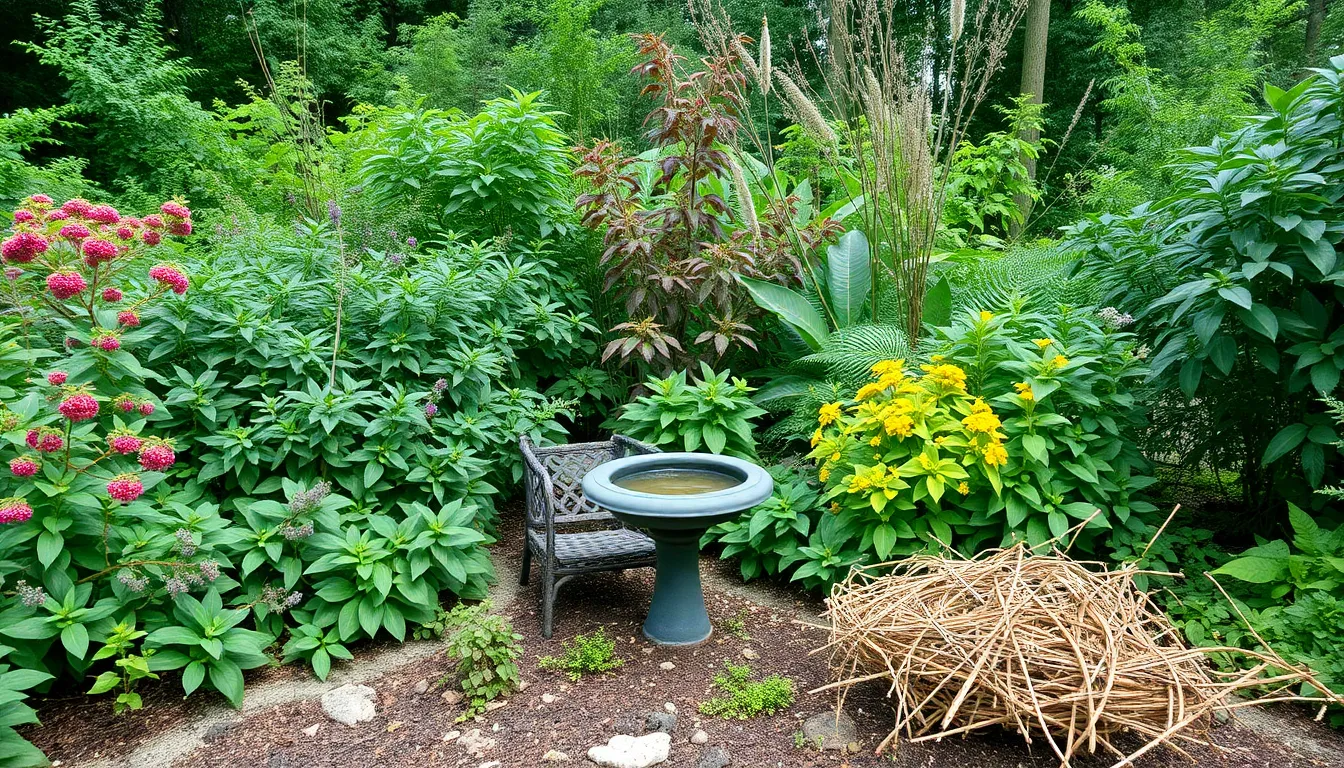
We can actively contribute to the success of nesting birds by creating environments that support their natural behaviors. Understanding their exact needs allows us to make meaningful improvements to our outdoor spaces.
Creating Bird-Friendly Garden Spaces
Native plants form the foundation of successful bird habitat design, providing both nesting materials and food sources that birds recognize and use effectively. We should prioritize species like elderberry, dogwood, and native grasses that offer flexible stems, soft fibers, and protective cover for nest construction.
Dense shrub layers create natural nesting zones at varying heights, accommodating different species’ preferences from ground nesters to canopy builders. Planting evergreen shrubs like juniper and pine provides year-round shelter, while deciduous options such as viburnum and serviceberry offer seasonal nesting opportunities with excellent concealment.
Water features enhance garden appeal for nesting birds by providing essential drinking and bathing resources within close proximity to nest sites. Shallow birdbaths, dripping fountains, or small ponds positioned 10-15 feet from dense vegetation give birds easy access while maintaining safety from predators.
Chemical-free gardening practices protect birds from harmful pesticides that can contaminate nesting materials and food sources. We eliminate herbicides, insecticides, and synthetic fertilizers that might poison adults or developing chicks, instead embracing organic pest control methods that support the entire network.
Layered vegetation structure mimics natural forest environments by incorporating ground cover, understory shrubs, and canopy trees. This diversity creates multiple microhabitats that attract various bird species and provides options for different nest building preferences and territorial requirements.
Providing Safe Nesting Materials
Natural material stations offer birds access to premium nest building supplies without requiring extensive foraging that might expose them to predators. We can create designated areas with small twigs, dried grass, moss, and animal fur collected from grooming pets or found naturally in our yards.
Yarn and string alternatives require careful selection to avoid materials that pose entanglement risks to birds or their offspring. Cotton strips cut to 4-6 inch lengths provide safe alternatives to synthetic materials, while natural fibers like sheep’s wool or alpaca fleece offer superior insulation properties.
Mud puddle creation supports species like robins, swallows, and phoebes that require clay-rich materials for nest construction. We maintain shallow depressions filled with clean soil and water, refreshing the mixture regularly to prevent bacterial growth while ensuring consistent availability during peak building season.
Hair and fur collection from pet grooming sessions provides excellent insulation material that birds readily incorporate into their nest linings. We avoid chemically treated or dyed fur, instead offering natural colors from dogs, cats, horses, or other domestic animals that haven’t received recent flea treatments.
Nesting material placement requires strategic positioning to maximize bird access while minimizing predator attraction. We position materials 15-20 feet from dense shrubs or trees, allowing birds to quickly grab supplies and retreat to safety without lingering in exposed areas.
Monitoring Without Disturbing
Observation distance guidelines help us enjoy nest building activities without causing stress or abandonment behaviors in parent birds. We maintain at least 15-20 feet from active nest sites during construction phases, using binoculars or telephoto camera lenses to observe detailed behaviors from safe distances.
Activity timing considerations recognize that birds are most active during early morning and late afternoon periods when nest building intensity peaks. We schedule our monitoring sessions during these natural activity windows while avoiding midday hours when birds typically rest or forage away from nest sites.
Photography ethics require restraint and respect for nesting birds’ privacy, particularly during sensitive egg laying and incubation periods. We avoid flash photography, limit session duration to 10-15 minutes, and immediately retreat if birds show signs of agitation like alarm calls or aggressive posturing.
Nest location documentation helps us track successful sites for future reference while maintaining appropriate boundaries around active nests. We mark locations with discrete flagging tape placed 25-30 feet away from nest sites, creating reference points that don’t interfere with bird behavior or attract unwanted attention.
Behavioral warning signs alert us when our presence causes stress, including repeated alarm calls, aggressive displays, or temporary nest abandonment. We recognize these signals immediately and increase our observation distance or suspend monitoring activities until birds resume normal nest building behaviors.
Conclusion
Understanding bird nest building reveals nature’s incredible engineering at work. We’ve explored how these remarkable creatures combine instinct with learned behavior to create safe havens for their offspring.
From material selection to architectural design birds demonstrate problem-solving abilities that rival human construction techniques. Their adaptability to environmental challenges and resource availability showcases millions of years of evolutionary refinement.
As we face climate change and habitat loss we can play a vital role in supporting nesting birds. Creating bird-friendly spaces with native plants and safe materials helps ensure these architectural marvels continue thriving in our shared environment.
The next time you spot a nest remember you’re witnessing one of nature’s most impressive accomplishments—a testament to survival ingenuity and parental dedication.
Frequently Asked Questions
What drives birds to build nests without any training?
Bird nest building is driven by complex biological programming that combines instinctual genetic blueprints with learned behaviors. Rising testosterone levels in males trigger construction activities during breeding season, while hormonal changes in females align with nest completion and egg-laying phases. Young birds inherit these genetic instructions and refine their skills through observation and experience.
How do birds choose the perfect location for their nests?
Birds consider multiple factors when selecting nest sites, including height for predator protection, dense vegetation for concealment, and proximity to food and water sources. They also evaluate weather protection and microclimate conditions. Urban birds often choose locations near human activity for unexpected protection, while territorial boundaries help secure exclusive resources for successful reproduction.
What materials do birds use to construct their nests?
Birds use both natural and human-made materials for nest construction. Natural materials include twigs, leaves, moss, bark strips, and spider silk for insulation and structural integrity. They’ve also adapted to incorporate human-made items like plastic, string, and fabric scraps. Species-specific preferences include hummingbirds using spider silk for elasticity and swallows utilizing mud and saliva.
What are the main types of bird nest designs?
Bird nests fall into three primary categories: cup nests (common among songbirds for secure egg enclosure), platform nests (used by larger birds like eagles for minimalist flat design), and cavity nests (created by woodpeckers for maximum predator protection). Some species also build burrows, hanging nests with advanced weaving techniques, or elaborate communal structures.
When is the best time for birds to build their nests?
Spring migration triggers the most intensive nest building period, with timing based on daylight hours and temperature stability. Early arrivals gain territorial advantages, while different species begin construction based on their specific food requirements. Climate change is advancing these schedules, with rising temperatures affecting traditional breeding cycles and nesting patterns.
What challenges do birds face during nest construction?
Birds encounter several challenges including weather disruptions like storms and droughts that destroy nests and limit material availability. Human interference through habitat loss, urban development, and noise pollution creates additional obstacles. Competition from other birds for territory and resources can force relocation, while extreme weather events disrupt traditional nesting patterns.
How can humans help support nesting birds?
Humans can create bird-friendly environments by planting native species that provide nesting materials and food sources. Creating dense shrub layers, water features, and practicing chemical-free gardening protects birds from harmful substances. Providing safe nesting materials like natural fibers and mud puddles aids construction, while respectful monitoring allows observation without causing stress to nesting birds.

